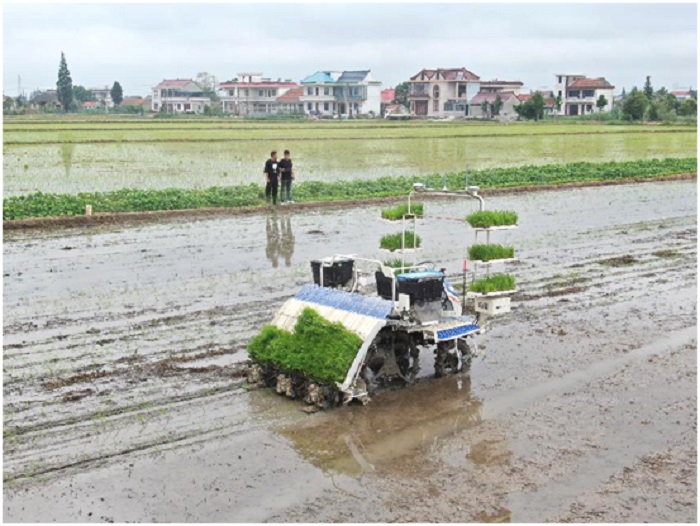



Intelligent agricultural machinery is now easily seen in farmlands across China. With the in-depth integration of AI into agriculture, farm work is becoming increasingly intelligent and more efficient, while agricultural production modes grow more effective.
In Fuyu county, Qiqihar City, northeast China’s Heilongjiang province, an unmanned tractor was leveling a cornfield that covers an area of about 53 hectares.
In Zhaoxian county, north China’s Hebei province, two intelligent tractors with a 120 horsepower engine and unmanned agricultural machinery for harvesting and transportation, all equipped with BeiDou Navigation Satellite System (BDS), worked in coordination with each other in a field after technicians set routes and gave instructions to them. Within 10 minutes, a furrow of cabbages was harvested.
In Henghe township, Cixi City, east China’s Zhejiang province, a self-driving transplanter worked automatically in a field. It is able to turn around and avoid obstacles on its own, ensuring continuity and stability of its operation.
Unmanned operating systems represent the most popular application of AI in agriculture. They can adapt to dozens of types of farm tools and enable agricultural machines to carry out tasks automatically in an accurate manner day and night.
The BDS adopted by unmanned agricultural machinery consists of a receiver, a millimeter wave radar sensor, an infrared camera, and a steering and drive control system, noted Han Wei, general manager of AIForce Tech, an agricultural robot provider.
With the BDS, technicians can ensure that self-driving agricultural machinery performs operations along a pre-set route. The positioning accuracy of the system can reach 2.5 centimeters.
After setting the routes for agricultural machines, technicians equip them with farm tools and give orders to make them carry out tasks in certain fields. Electronic fences have been designed to prevent agricultural machines from deviating from the fields.
Unmanned operating systems are not only efficient, safe, and suitable for fine management, but are easy to operate.
Intelligent agricultural machinery operators only need to adjust settings of the machinery according to field conditions and then control machines remotely via their mobile phones, allowing self-driving machines, including tractors, to work automatically even for dozens of hours in a row, said a farmer surnamed Han, who is a member of the agricultural cooperative of Fuyu county.
Researchers of AIForce Tech estimated that unmanned operating systems had improved the overall efficiency of agricultural operations by 30 percent.
AI is being rapidly integrated into agricultural scenarios in China. Agricultural robots are an essential part of AI application in agriculture, said Li Deyi, an academician with the Chinese Academy of Engineering and the chief scientist at AIForce Tech, who pointed out that the current global agricultural robot market focuses on unmanned tractors, plant protection drones, spraying drones, farmland inspection robots, robotic milking machines, and fruit-picking robots, among which unmanned tractors and spraying drones are the main force of agricultural robots in China.
According to Li, the country will further enhance the R&D of agricultural robots, expand the application scenarios of AI in agriculture, explore unmanned farms, and materialize the overall solution of intelligent farms.


The Executive and members of the.


The Acting Director, FCT Directorate of.


President Bola Ahmed Tinubu has been.



Barely a month after resignation of.


An Abuja based Legal Practitioner, Osuagwu.



Convener of Equitable Remedy, Mrs. Magaret.


Contractors handling the contract for city.


Nigerian government may have concluded plans.


The Diplomatic Correspondents Association of Nigeria.


A rights group, “Follow Me Talk.
Leave a Comment